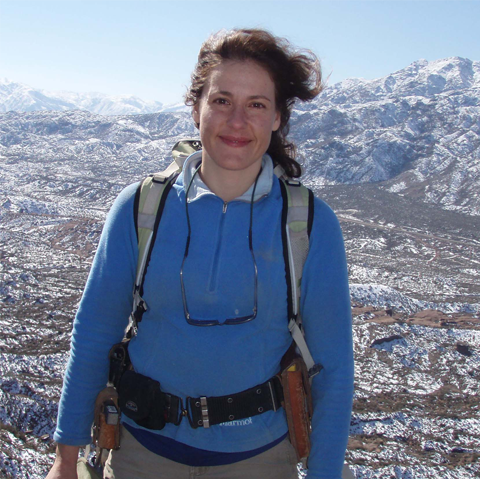Science news
5-Jun-2008 14:00 Eastern US Time
Mountain ranges rise rapidly
The Andes Mountains went through a spurt in growth that doubled their height in a far shorter time than was previously thought possible, according to new research.
This surge lasted 2-4 million years - which is a long time in human terms, but the blink of an eye to geologists. It is in fact about ten times as fast as the existing theory of plate tectonics would predict, says Carmala Garzione, associate professor of geology at the University of Rochester. The theory will therefore have to be altered to include something known as delamination.
Sudden spurt
Garzione has been collaborating with John M. Eiler, professor of geochemistry at California Institute of Technology, and Prosenjit Ghosh, assistant professor of atmospheric and oceanic sciences at the Indian Institute of Science in Bangalore. Their paper is published today in the journal Science.
The chemical composition of a mountain's soil is affected by rainfall and surface temperature. So the scientists have been using recently developed techniques to study the chemical composition of sedimentary basins in the high Andes Mountains. From this they could work back to rainfall and temperature. They could then use these to estimate the altitudes at which the ancient sediments were laid down. They could also work out when this happened.
That record of altitude changes showed them that the Andes Mountains at first rose slowly for tens of millions of years. Then suddenly they began to grow much faster. This spurt took place between 6 and 10 million years ago.
Broad support
Related research using other methods supports this conclusion. Gregory D. Hoke has been looking at how rivers carved deep canyons into the flanks of the Andes as the mountain range rose. He is one of Garzione's post-doctoral research fellows.
Hoke has dated the canyons and mapped their depth and extent. This shows that it was not just the Andes that grew rapidly. A broad region more than 350 miles wide rose along with them. These findings will be published soon in the journal Earth and Planetary Science Letters.
The surface uplift Garzione found in the sedimentary basin happened right across the width of the Andes Mountains, says Hoke.
Mountain evidence
In today's Science paper the researchers discuss the evidence that is now gathering for a hotly-debated process called delamination. A broad range of geological indicators - erosion, volcanic eruptions, sediment accumulation, the history of folding and faulting - suggest this dramatic process does happen. So do these latest findings.
Delamination has been discussed for decades, says Garzione. But mechanical models of mountain-building have a hard time reproducing it. And until now there have been no reliable palaeo-elevation measurements.
Losing the layers
Geologists agree that when ocean and continental plates come together the continental crust buckles. On the surface this is seen as young mountain-ranges rising. Beneath the crust the buckling creates a heavy, high-density "root" that holds the crust down like an anchor.
The difference between traditional plate tectonics and the same theory with delamination lies in what happens to this root. According to the normal theory, convection currents of the fluid mantle, deep in the Earth, slowly erode the root, like a stream wearing down a rock. This lets the mountains gradually rise, as that piece of the crust becomes lighter.
But with delamination the root heats up and oozes down like a drop of molasses. Then it suddenly breaks free and sinks into the mantle. The mountains above, suddenly free of the blob's weight, rush upward and, in the case of the Andes, rise from less than two kilometres to four in under 4 million years.
High and wide
Wider questions about mountains that grow rapidly arise from the effects they would have on climate and evolution, says Garzione. Further research with palaeontologist colleagues - Darin Croft at Case Western Reserve University and Bruce MacFadden at the University of Florida - will be aimed at trying to answer some of these questions.
In particular these researchers are now starting to study how a fast-rising mountain range would affect regional climate and biodiversity in South America, in the late Miocene, when the Andes rose.
This research was funded by the National Science Foundation.
More help with words
| atmosphere | core | crust | energy | epoch |
| evidence | fertile | fossils | geologic time | mantle |
| seismic | species | suspension | theory | volcano |
What's it all about?
- Which mountains have the scientists been studying?
- What happened to the height of these mountains?
- How long did this take?
- Why was this a surprise?
- What will now have to be included in the theory of plate tectonics, according to Garzione?
- State two factors that affect the chemical composition of a mountain's soil.
- What have the scientists been studying?
- What did they use this to work out first?
- What did that let them estimate next?
- They also worked out what?
- What did all this tell them happened to the Andes for tens of millions of years?
- Then suddenly what happened?
- What has Hoke been studying?
- What has he found?
- These new findings seem to provide evidence for delamination. What kind of evidence was there for this already?
- Give one reason scientists have been slow to agree that delamination occurs.
- What causes young mountains to rise?
- What happens to the high-density root of the mountain range in normal plate tectonics?
- What happens to the high-density root of the mountain range if delamination happens?
- Explain briefly why the new findings strongly suggest that delamination actually did take place in the Andes.


